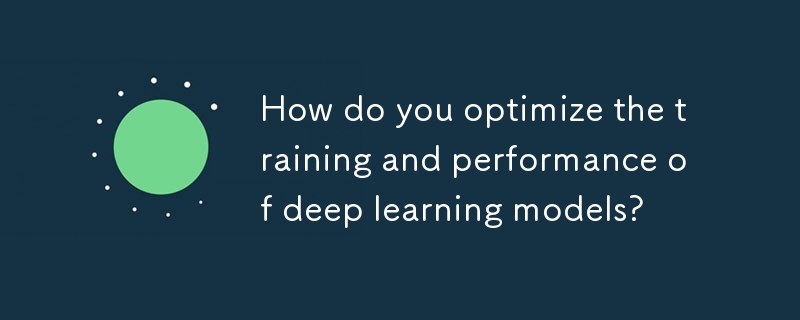 Backend Development
Backend Development
 Python Tutorial
Python Tutorial
 How do you optimize the training and performance of deep learning models?
How do you optimize the training and performance of deep learning models?
How do you optimize the training and performance of deep learning models?

Understanding Keras Long Short-Term Memory (LSTM)
Before discussing the title question, let’s review the background.
Question:
- Selection criteria of loss function
- Advantages and disadvantages of weight update rules
- Training a good network Tips
- Principles of hyperparameter adjustment for deep learning models
Answer:
Loss function selection criteria:
- The choice of loss function depends on the nature of the training task and data.
- Commonly used loss functions include mean square error (MSE), cross entropy (CE), and KL divergence.
- For regression tasks, MSE is a common choice.
- For classification tasks, CE is widely used in binary and multi-classification problems.
- KL divergence measures the difference between two probability distributions.
Advantages and disadvantages of weight update rules:
- Gradient descent is the most commonly used weight update rule in deep learning.
- Advantages of gradient descent include ease of implementation and wide applicability.
- Disadvantages of gradient descent may include local optima and slow convergence.
- Other weight update rules include momentum, adaptive moment estimation (Adam), and RMSprop. These rules are designed to improve convergence speed and stability by employing different learning rate strategies.
Tips for training a good network:
- Data preprocessing: Proper data preprocessing (e.g. normalization , standardization) can improve model performance and increase convergence speed.
- Hyperparameter tuning: Hyperparameters (e.g. learning rate, batch size, network architecture) are tuned through techniques such as cross-validation or Bayesian optimization to optimize model performance.
- Regularization: Regularization techniques such as L1, L2 regularization, and dropout help prevent overfitting and improve model generalization.
- Data augmentation: Data augmentation techniques (such as image rotation, flipping, cropping) can generate more data samples, thereby improving the robustness and performance of the model.
Principles for hyperparameter adjustment of deep learning models:
- Grid search: Grid search is the most effective way to adjust hyperparameters. Simple method that performs a comprehensive evaluation of a set of discrete values of hyperparameter values.
- Random Search: Random search is more efficient than grid search because it randomly samples candidate values in the hyperparameter space for evaluation.
- Bayesian Optimization: Bayesian optimization uses Bayes’ theorem to step-by-step guide the hyperparameter search process to maximize the objective function (such as model accuracy).
- Reinforcement Learning: Reinforcement learning is an advanced hyperparameter tuning technique that uses a reward mechanism to optimize hyperparameter selection.
By understanding these principles and applying these techniques, you can optimize the training and performance of your deep learning models.
The above is the detailed content of How do you optimize the training and performance of deep learning models?. For more information, please follow other related articles on the PHP Chinese website!

Hot AI Tools

Undresser.AI Undress
AI-powered app for creating realistic nude photos

AI Clothes Remover
Online AI tool for removing clothes from photos.

Undress AI Tool
Undress images for free

Clothoff.io
AI clothes remover

Video Face Swap
Swap faces in any video effortlessly with our completely free AI face swap tool!

Hot Article

Hot Tools

Notepad++7.3.1
Easy-to-use and free code editor

SublimeText3 Chinese version
Chinese version, very easy to use

Zend Studio 13.0.1
Powerful PHP integrated development environment

Dreamweaver CS6
Visual web development tools

SublimeText3 Mac version
God-level code editing software (SublimeText3)

Hot Topics
 How to avoid being detected by the browser when using Fiddler Everywhere for man-in-the-middle reading?
Apr 02, 2025 am 07:15 AM
How to avoid being detected by the browser when using Fiddler Everywhere for man-in-the-middle reading?
Apr 02, 2025 am 07:15 AM
How to avoid being detected when using FiddlerEverywhere for man-in-the-middle readings When you use FiddlerEverywhere...
 How to handle comma-separated list query parameters in FastAPI?
Apr 02, 2025 am 06:51 AM
How to handle comma-separated list query parameters in FastAPI?
Apr 02, 2025 am 06:51 AM
Fastapi ...
 How to solve permission issues when using python --version command in Linux terminal?
Apr 02, 2025 am 06:36 AM
How to solve permission issues when using python --version command in Linux terminal?
Apr 02, 2025 am 06:36 AM
Using python in Linux terminal...
 How to teach computer novice programming basics in project and problem-driven methods within 10 hours?
Apr 02, 2025 am 07:18 AM
How to teach computer novice programming basics in project and problem-driven methods within 10 hours?
Apr 02, 2025 am 07:18 AM
How to teach computer novice programming basics within 10 hours? If you only have 10 hours to teach computer novice some programming knowledge, what would you choose to teach...
 Python asyncio Telnet connection is disconnected immediately: How to solve server-side blocking problem?
Apr 02, 2025 am 06:30 AM
Python asyncio Telnet connection is disconnected immediately: How to solve server-side blocking problem?
Apr 02, 2025 am 06:30 AM
About Pythonasyncio...
 How to get news data bypassing Investing.com's anti-crawler mechanism?
Apr 02, 2025 am 07:03 AM
How to get news data bypassing Investing.com's anti-crawler mechanism?
Apr 02, 2025 am 07:03 AM
Understanding the anti-crawling strategy of Investing.com Many people often try to crawl news data from Investing.com (https://cn.investing.com/news/latest-news)...
 Python 3.6 loading pickle file error ModuleNotFoundError: What should I do if I load pickle file '__builtin__'?
Apr 02, 2025 am 06:27 AM
Python 3.6 loading pickle file error ModuleNotFoundError: What should I do if I load pickle file '__builtin__'?
Apr 02, 2025 am 06:27 AM
Loading pickle file in Python 3.6 environment error: ModuleNotFoundError:Nomodulenamed...
 What is the reason why pipeline files cannot be written when using Scapy crawler?
Apr 02, 2025 am 06:45 AM
What is the reason why pipeline files cannot be written when using Scapy crawler?
Apr 02, 2025 am 06:45 AM
Discussion on the reasons why pipeline files cannot be written when using Scapy crawlers When learning and using Scapy crawlers for persistent data storage, you may encounter pipeline files...





